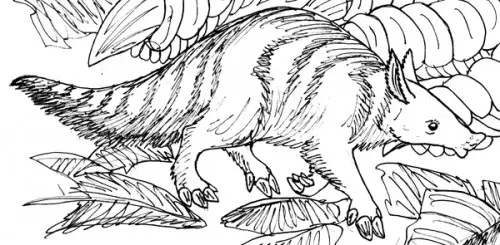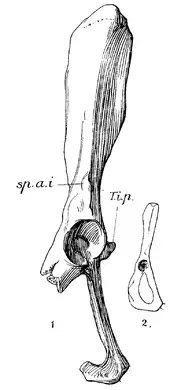Plesiorycteropus
Also known as the Malagasy aardvark or bibymalagasy, the Plesiorycteropus is a recently extinct mammal from Madagascar. Knowledge of the skeletol anatomy of the Plesiorycteropus is limited, as only partial skeletons have been recovered to date.

Reconstruction of the mysterious Pleistocene mammal, Plesiorycteropus madagascarensis, as an aardvark-like animal.
It was first described as Plesiorycteropus madagascariensis by the French Naturalist, Henri Filhol, in 1895. This was based on a partial skull that was found at the Cave of Belo. His description was rather vague even for the standards of the 19th century, but he placed this animal as being close to the aardvark. In 1946, Charles Lamberton who had access to a larger sample noted a substantial variation but did not try to differentiate that it was a seperate species. Ross MacPhee reviewed the Plesiorycteropus in 1994 and was able to separate two species – the larger Plesiorycteropus madagascariensis, and a newer and smaller species called Plesiorycteropus germainepetterae.
In history, the Plesiorycteropus’ remains were actually misidentified as being primates and rodents. In fact, Charles Immanuel Forsyth Major described it as a giant subfossil rate in 1908 based on two pelvic bones. Guillaume Grandidier also assigned a well-preserved femur to a large rodent. Another Plesiorycteropus bone found was mistakenly assigned to a giant aye-aye, while others have misidentified bones as being of a dwarf lemur.
As mentioned above, the Plesiorycteropus is known via a number of subfossil bones. These bones include several skulls which are all missing facial bones. Complete long bones include the humerus and the femur. Other bones have also been unearthed. Some elements are still unknown, such as the skeleton of the hand and foot. No teeth or jaws have also been found, so it has been assumed that this animal was toothless. There is actually also very little reason to assume that it was similar in form to an aardvark.
Ross MacPhee calculated estimates of the Plesiorycteropus’ body mass, based on the area of a sample femur’s cross-section. The lowest estimate based on comparative data from pangolins and armadillos was 6 kg. The smallest femur referred based on comparative data from caviomorph rodents was 18 kilograms.
It is thought that the Plesiorycteropus’ forelimbs were specialised for scratch-digging. It is assumed that this animal was in either an erect or sitting posture. It may have also been a climber. They most likely ate insects like termites and ants. However, it also may have eaten other soft food.
Not much is known about the extinction of the Plesiorycteropus but MacPhee assumed it happened 1000 years ago when the extinction of the rest of the Madagascan sub-fossil fauna also concluded. 17th century European Explorers did not report about this animal. One bone was carbon dated back to around 200 BC.




I have no if I’ve ever seen this animal on the internet… ene
It seems worthy of study… I SHA’LL LOOK THIS ANIMAL UP!
Appreciation you…
https://www.youtube.com/@SupremeAudiobooks